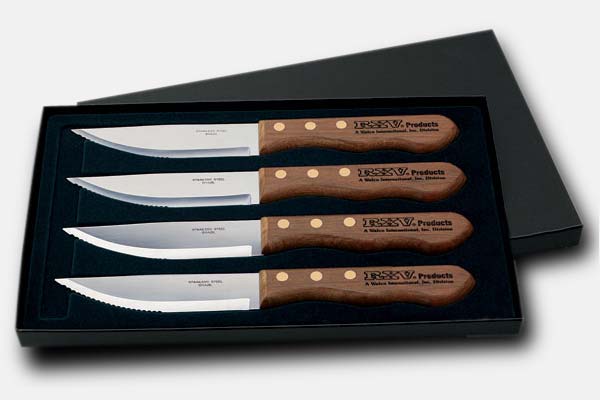Non serrated knives are blades with straight and sharp edges. In contrast, serrated knives feature a tooth-like edge, designed to saw through the hard exterior.
Regardless of the type, however, non serrated steak knives and serrated knives are fashioned out of processed steel.
Quality knives, not specifically the most expensive, should possess the following characteristics:
- Hardness – The standard Rockwell Hardness Scale measures hardness. It is a way to measure the tensile strength of the blade. For instance, knives generally fall with the hardness Rockwell C standard of 58-62. The higher the number, the stronger the steel is.
However, it doesn’t mean that you should automatically choose a knife with the highest number on the Rockwell scale. For instance, the knives from Foxel measure at 56-58 on the scale. It took a lot of research to arrive at the perfect number. This measurement means that the blades are hard enough to resist bending but soft enough so you can hone their edges.
- Resistance to rust and corrosion – Aluminum steel blades resist rust and corrosion, but their make is out of soft material, which means they are susceptible to bending. Quality knives should be hard enough to resist bending but also appropriately processed to ward off rust. Typically, manufacturers add chromium into the mix. This will help protect the blade, especially from its constant exposure to salt, humidity, moisture, and pressure.
- Resistance to wear and tear – Resistance to wear and tear is the ability of the blade to maintain its integrity despite being in constant contact with objects. In most instances, you are going to hit hard objects such as bone when you are preparing food. Wear resistance depends on the hardness of the blade, as well as the chemistry of the knife.
Check this: KITCHEN TOOLS AND EQUIPMENT
When measuring wear resistance, the tests typically look at the adhesive and abrasive quality of the blade. They test for adhesiveness by rounding off the edges. And they check for abrasiveness by rubbing the tip against sandpaper, among others.
- Toughness – Toughness is different from hardness. The blade is subjected to a series of stress tests to determine resistance to breakage, cracks, and chips. Among the factors that affect toughness is the heat treatment applied to the blade, as well as the grinding method.
In terms of testing, there’s no accepted standard like with the hardness level outlined in the Rockwell scale.
Unfortunately, the toughness and ability of the knife to avoid wear and tear will only show up over time. You can’t determine the blade quality beforehand. You will have to buy serrated and non serrated knives first and cross your fingers afterward.
The best thing you can do is probably avoid the brand after buying one of their products and finding out they are not up to your expectations.
But as already mentioned, a high-quality knife doesn’t have to be expensive. Take, for instance, the Foxel knives, which set themselves apart by the quality craftsmanship, aesthetics, and affordability. Foxel utilizes German-engineering with its knives and has also invested a lot of money into research to come up with the perfect blade for your kitchen.

Leave a Reply